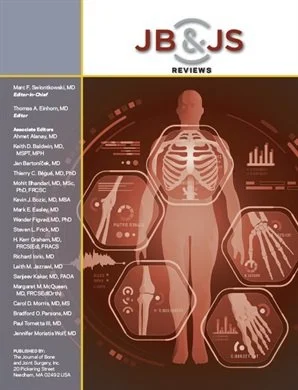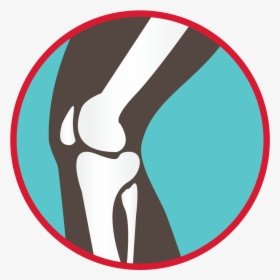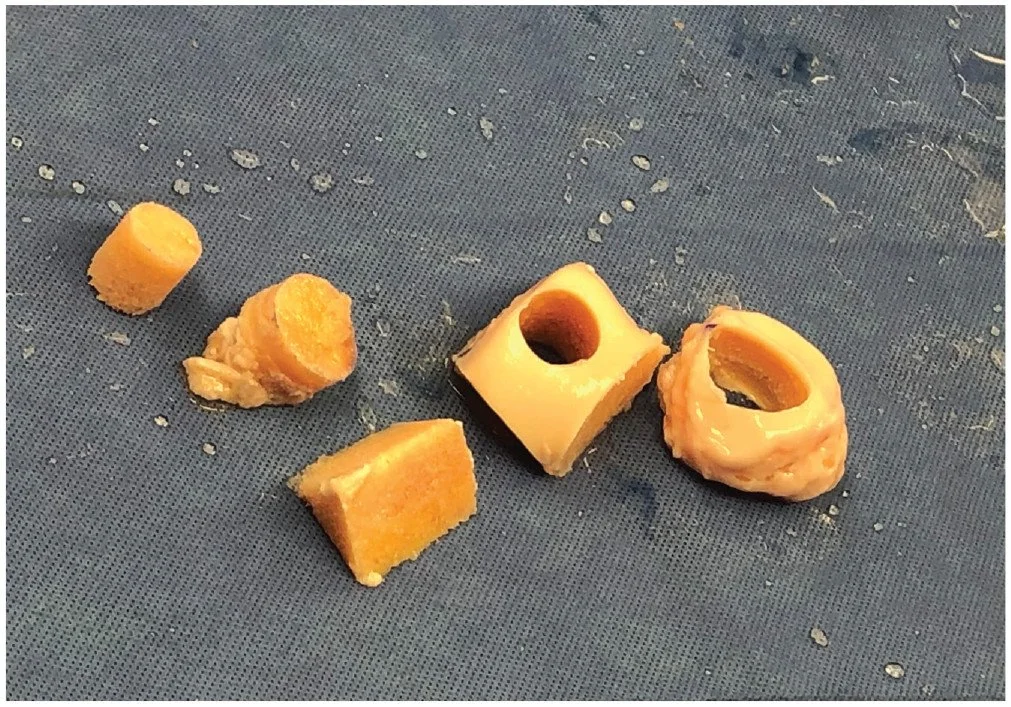
PUBLISHED
RESEARCH
AFTER CHONDROPLASTY, PATIENT ELECTION TO PROCEED WITH CARTILAGE TRANSPLANTATION IS CLOSELY AND ADDITIVELY ASSOCIATED WITH PREOPERATIVE AMADEUS GRADE…
To identify risk factors for patient election to proceed with cartilage transplant after staging chondroplasty.
This study retrospective reviewed patients prospectively enrolled at the time of staging chondroplasty, with early election defined as patient decision to proceed to cartilage transplantation within 6 months of chondroplasty. Cox proportional hazards analysis was used to determine univariate predictors of conversion, and a predictive calculator, the Cartilage Early Return for Transplant score, was formulated using stepwise regression employing the Akaike information criterion. Receiver operator curves and the area under the curve were used to evaluate the predictive ability of the final model on the studied patient population.
ANATOMIC FACTORS ASSOCIATED WITH OSTEOCHONDRAL ALLOGRAFT MATCHING FOR TROCHLEAR CARTILAGE DEFECTS: A COMPUTER-SIMULATION STUDY
Computed tomography images of 10 cadaveric trochlear specimens were obtained to generate 3-dimensional models. Circular defects were created virtually in the recipient trochleae at both superolateral (18.0 mm and 22.5 mm) and central (18.0 mm, 22.5 mm, 30.0 mm) locations. The donor models were virtually projected onto the defect models, and the most optimal graft from any location of the donor specimen was selected. Cartilage incongruity, subchondral bone incongruity, and peripheral articular step-off were calculated for each graft-defect combination. Linear regression models were generated to identify predictors of incongruity, step-off, and the effect of sulcus and sagittal angle mismatch. Akaike information criterion–driven stepwise regression models were generated to identify multivariate predictors.
ARTHROSCOPIC TREATMENT OF FEMOROACETABULAR IMPINGEMENT USING LABRAL RECONSTRUCTION WITH CAPSULAR AUTOGRAFT
The acetabular labrum is essential for stability during physiologic motion of the hip. Labral repairs frequently are attempted in cases of primary tears, although labral reconstruction is an important alternative in the revision setting or in the primary setting when the tissue is unsalvageable.
FRAGILITY OF STATISTICALLY SIGNIFICANT FINDINGS FROM RANDOMIZED CLINICAL TRIALS OF SURGICAL TREATMENT OF HUMERAL SHAFT FRACTURES: A SYSTEMATIC REVIEW
We completed a systematic review of RCTs evaluating the surgical treatment of humeral shaft fractures. Inclusion criteria included: articles published in English; patients randomized and allotted in 1:1 ratio to 2 parallel arms; and dichotomous outcome variables. The FI was calculated for total complications, each complication individually, and secondary surgeries using the Fisher exact test, as previously published.
RETURN TO WORK FOLLOWING SHOULDER ARTHROPLASTY: A SYSTEMATIC REVIEW
This systematic review and analysis was performed in accordance with Preferred Reporting Items for Systematic Reviews and Meta-Analyses guidelines. A literature search regarding RTW following shoulder arthroplasty was performed using four databases (PubMed, Scopus, Embase, and Cochrane Library), and the Reference Citation Analysis (https://www.referencecitationanalysis.com/). All studies in English relevant to shoulder arthroplasty and RTW through January 2021 that had a level of evidence I to IV were included. Nonclinical studies, literature reviews, case reports, and those not reporting on RTW after shoulder arthroplasty were excluded.
ARTHROSCOPIC MANAGEMENT OF STIFFNESS AND ANTERIOR SHOULDER PAIN FOLLOWING REVERSE SHOULDER ARTHROPLASTY
Arthroscopy following shoulder arthroplasty has primarily been described as a diagnostic tool in the setting of unexplained pain. However, this tool also can be used to potentially manage postoperative stiffness and pain following reverse shoulder arthroplasty. This Technical Note provides a stepwise approach to assessing and addressing limitations in range of motion as well as causes of postoperative impingement following reverse shoulder arthroplasty.
CURRENT AND FUTURE ADVANCED IMAGING MODALITIES FOR THE DIAGNOSIS OF EARLY OSTEOARTHRITIS OF THE HIP
Hip osteoarthritis (OA) can be idiopathic or develop secondary to structural joint abnormalities of the hip joint (alteration of normal anatomy) and/or due to a systemic condition with joint involvement. The purpose of this review was to summarize the results of translational and clinical studies investigating the utilization of the above-mentioned imaging modalities to diagnose hip pre-OA, with special focus on recent research evaluating their implementation into clinical practice.
ATHLETES PERCIEVE WEIGHTED BASEBALLS TO CARRY A NOTABLE INJURY RISK, YET STILL USE THEM FREQUENTLY: A MULTICENTER SURVEY STUDY
Weighted baseball use in throwing programs is widespread; however, their use remains controversial. Prior research shows that weighted baseball programs can increase ball velocity but potentially increase throwing arm injuries. This study aims to ascertain perceptions of weighted baseballs among elite baseball players.
MCL & POL RECONSTRUCTION FOR VALGUS INSTABILITY AFTER TOTAL KNEE ARTHROPLASTY
Medial collateral ligament (MCL) injuries are typically managed non-operatively, with high rates of clinical success. However, patients who present with medial knee laxity with valgus stress testing of a fully extended knee, anteromedial rotatory instability, associated tibial plateau fracture, or multiligament injury or those who continue to be symptomatic after non-operative treatment may benefit from surgical intervention. Patients with a history of total knee arthroplasty who suffer MCL and posterior oblique ligament (POL) injuries represent a challenging patient population and often require surgical attention. In this Technical Note, we describe the preoperative assessment, decision making, and surgical technique for anatomic reconstruction of the superficial MCL and POL with an Achilles allograft in young, active patients with medial-sided knee injuries after total knee arthroplasty.
POSTERIOR HUMERAL AVULSION OF THE CLENOHUMERAL LIGAMENT A CRITICAL ANALYSIS REVIEW
Posterior humeral avulsions of the inferior glenohumeral ligament represent an increasingly recognized but likely underdiagnosed source of posterior shoulder instability and pain.
Injuries are commonly reported in athletic individuals who have sustained injury by either traumatic or atraumatic mechanisms; the ligament is most susceptible to injury with the shoulder in flexion, adduction, and internal rotation.
DEFINING THE MINIMAL CLINICALLY IMPORTANT DIFFERENCE AND PATIENT ACCEPTABLE SYMPTOM STATE AFTER ENDOSCOPIC GLUTEUS MEDIUS OR MINIMUS REPAIR…
There is a paucity of information in the literature on midterm outcomes of endoscopic gluteus medius and/or minimus repair with concomitant labral treatment using only modern surgical techniques.
We aim to define the minimal clinically important difference (MCID) and Patient Acceptable Symptom State (PASS) at a minimum of 5 years postoperatively for patients undergoing endoscopic hip abductor repair with routine capsular closure.
OUTCOMES OF PATELLAR SUBCHONDROPLASTY SURGERY: A CASE SERIES
The purpose of this study is to report preliminary outcomes of patients who have undergone subchondroplasty of the patella. The surgical log of the senior author was retrospectively reviewed to identify patients who had undergone patellar subchondroplasty from January 2014 to June 2019. Indications for surgery included the presence of retropatellar pain refractory to conservative management without significant arthritis with a related focal BML on magnetic resonance imaging. I
HIP ARTHROSCOPY FOR THE TREAMENT OF FEMOROACETABULAR IMPINGEMENT SYNDROME IN HIPS WITH MILD OSTEOARTHRITIS(Tönnis Grade 1)
There is a paucity of information in the literature on midterm outcomes from the arthroscopic treatment of femoroacetabular impingement syndrome (FAIS) with concomitant labral treatment in patients with mild osteoarthritis (OA) using modern surgical techniques.
Our objective is to compare outcomes of hip arthroscopy for the treatment of FAIS between patients with mild OA (Tönnis grade 1) and patients without OA (Tönnis grade 0) at minimum 5-year follow-up.
HUMERAL HEAD RESURFACING FOR ISOLATED PRIMARY HUMERAL OSTEOARTHRITIS WITH A LARGE CHONDRAL DEFECT
Primary, isolated humeral head arthritis or focal chondral defects are uncommon and difficult to diagnose preoperatively. While these lesions have traditionally been treated with total shoulder arthroplasty, shoulder hemiarthroplasty is a viable option for patients with isolated humeral head disease and minimal degenerative changes in the glenoid. This approach can be performed in a minimally invasive fashion, which preserves bone stock and native biomechanics, and can be beneficial if conversion to total shoulder arthroplasty is required in the future and avoids risk of glenoid loosening or failure in younger and more active individuals. In this Technical Note and accompanying video, we describe our technique of humeral head resurfacing in a patient with isolated primary humeral osteoarthritis with a large focal chondral defect in the humeral head.
TIME TO ACHIEVING CLINICALLY SIGNIFICANT OUTCOMES AFTER MENISCAL ALLOGRAFT TRANSPLANTATION
To determine the time to achieving minimal clinically important difference (MCID) and patient acceptable symptomatic state (PASS) for commonly administered patient-reported outcome (PRO) measures and risk factors affecting achievement of clinically significant outcomes in patients undergoing meniscal allograft transplantation (MAT)
CONCUSSIONS IN THE WOMEN’S NATIONAL BASKETBALL ASSOCIATION: ANALYSIS OF INCIDENCE, RETURN-TO-PLAY TIMING, AND PLAYER PERFORMANCE FROM 1997 TO 2020
Publicly available records were searched to identify all documented basketball-related concussions from WNBA seasons 1997 to 2020. Player demographics, injury details, and basketball career information were collected. Concussion incidence and return-to-play (RTP) timing were evaluated before and after the institution of the WNBA concussion protocol in 2012. Minutes per game and game score per minute were compared 5 games before and 5 games after the concussion was sustained. Player game availability and RTP performance were also compared with an age-, body mass index–, position-, and experience-matched control group of players who did not sustain any injuries during the index season.
EFFECT OF MECHANICAL MINCING ON MINIMALLY MANIPULATED ARTICULAR CARTILAGE FOR SURGICAL TRANSPLANTATION
Point-of-care treatment options for medium to large symptomatic articular cartilage defects are limited. Minced cartilage implantation is an encouraging single-stage option, providing fresh viable autologous tissue with minimal morbidity and cost.
Our objective is to determine the histological properties of mechanically minced versus minimally manipulated articular cartilage.
ULTRASOUND CAN DETERMINE JOINT DISTRACTION DURING HIP ARTHROSCOPY BUT FLUOROSCOPIC-GUIDED PORTAL PLACEMENT IS SUPERIOR
To compare joint distraction measured on ultrasound (US) with joint space width (JSW) measured on fluoroscopy in hip arthroscopy and to determine whether ultrasound guidance is as safe and effective as fluoroscopy, the current gold standard, for establishing arthroscopic portals.
A 135° SHORT INLAY HUMERAL STEM LEADS TO COMPARABLE RADIOGRAPHIC AND CLINICAL OUTCOMES COMPARED WITH A STANDARD-LENGTH STEM FOR REVERSE SHOULDER ARTHROPLASTY
Patients who underwent RTSA using a press-fit standard- or short-length humeral component with a consistent geometry (Univers Revers, or Revers Apex; Arthrex, Inc., Naples, FL, USA) were evaluated in a multicenter retrospective review. The minimum clinical follow-up was 2 years. Immediate postoperative radiographs were used to assess initial alignment and filling ratios. In addition, radiographs at 2 years were evaluated for signs of stress shielding and/or loosening. Clinical outcome scores and range of motion were evaluated at the final follow-up and compared between groups.





















